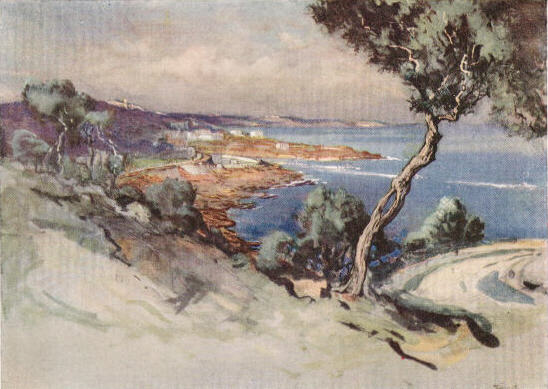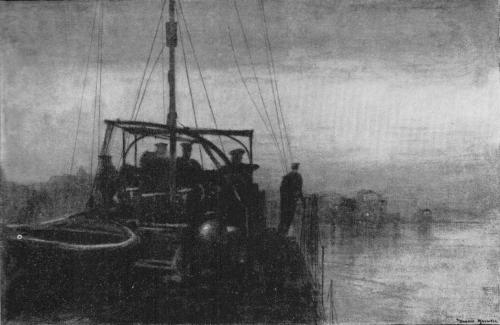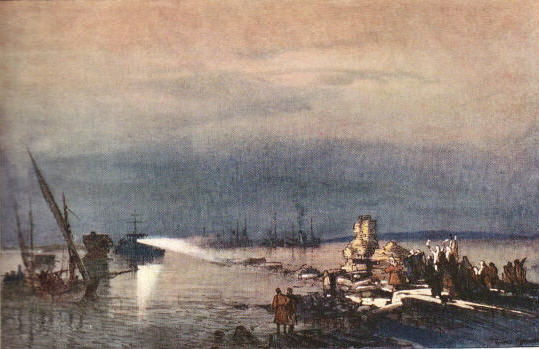The Last Crusade by Donald Maxwell
Near the end of the war Lieutenant Donald Maxwell, RNVR, was transferred "by the Admiralty from a patrol on the East Coast to the Department of Naval Intelligence, with instructions to prepare to take up certain duties in Mesopotamia." As Maxwell noted "...I should be in command of a paint box instead of a patrol boat; but ours 'is not to reason why' especialy when we like the job..." Thus, off he went to the Mediterranean to document the war effort in paint for the Admiralty. Along the way he met many in the Motor Launch Patrol—being the former commander of ML 139 himself the attraction seems natural. We are lucky that the books which grew out of this adventure documents the ML's of the Mediterranean as much as any other aspect of the war in that region—adding the other major glimpse into ML life in addition to Gordon Maxwell's The Motor Launch Patrol.
Included here are various short excerpts from the text and a number of paintings and sketches depicting the ML's that Maxwell encountered.
Near the end of the war Lieutenant Donald Maxwell, RNVR, was transferred "by the Admiralty from a patrol on the East Coast to the Department of Naval Intelligence, with instructions to prepare to take up certain duties in Mesopotamia." As Maxwell noted "...I should be in command of a paint box instead of a patrol boat; but ours 'is not to reason why' especialy when we like the job..." Thus, off he went to the Mediterranean to document the war effort in paint for the Admiralty. Along the way he met many in the Motor Launch Patrol—being the former commander of ML 139 himself the attraction seems natural. We are lucky that the books which grew out of this adventure documents the ML's of the Mediterranean as much as any other aspect of the war in that region—adding the other major glimpse into ML life in addition to Gordon Maxwell's The Motor Launch Patrol.
Included here are various short excerpts from the text and a number of paintings and sketches depicting the ML's that Maxwell encountered.
II.-PISGAH HEIGHTS
THE little harbour at Tricase will always live in the memory of Motor Launch adventurers in the Adriatic, for it was used exclusively by ML's, no others of His Majesty's ships being able to adapt themselves to its Lilliputian proportions. Those boats at work on the Otranto anti-submarine barrage were wont to run in there for shelter, and as many as six have been known to berth there at once. Airmen reported that on these occasions a more splendid imitation of a newly opened sardine tin could not be imagined when viewed from a height, and the first glimpse vouchsafed to a traveller coming along the coast road was that of a most cunningly staged musical comedy at Daly's. The legend firmly believed in by all true Emellites,* concerning the shoal in the fairway at the entrance to the harbour, is generically true even if apochryphal in its origin. The story goes that the commanding officer of an ML was showing a brick to his sub. How he came to have a brick on board in a country where only stone abounds I do not know unless it was for this reason regarded as a curio, or why he was leaning over the side of his boat when handling it is not apparent.
THE little harbour at Tricase will always live in the memory of Motor Launch adventurers in the Adriatic, for it was used exclusively by ML's, no others of His Majesty's ships being able to adapt themselves to its Lilliputian proportions. Those boats at work on the Otranto anti-submarine barrage were wont to run in there for shelter, and as many as six have been known to berth there at once. Airmen reported that on these occasions a more splendid imitation of a newly opened sardine tin could not be imagined when viewed from a height, and the first glimpse vouchsafed to a traveller coming along the coast road was that of a most cunningly staged musical comedy at Daly's. The legend firmly believed in by all true Emellites,* concerning the shoal in the fairway at the entrance to the harbour, is generically true even if apochryphal in its origin. The story goes that the commanding officer of an ML was showing a brick to his sub. How he came to have a brick on board in a country where only stone abounds I do not know unless it was for this reason regarded as a curio, or why he was leaning over the side of his boat when handling it is not apparent.

Tricase
The Last Crusade
|
However, for some reason or other he had a brick and he was holding it out in the manner stated when, owing to some momentary carelessness, he let it fall and the fairway was blocked. Efforts on the part of the whole fleet to recover this brick were unavailing, and boats after that were constantly "going aground." The general locality of this obstacle was known, however, so it was marked on the chart as a shoal and by cautious navigation ML's were still able to make their way in and out of the harbour.
(* I might explain for the benefit of the uninitiated that an Emellite is a man who dwells in an ML To many it may seem a piece of gratuitous information, but it may prevent any more of my readers searching for a tribe of aborigines instead of for motor launch officers in South Italy.)
The Glory of Lebanon
Besides the derelict war craft I have mentioned, there are also, in one corner of the harbour ar Beirut, some sunken tugs and other boats - I think scuttled by the Turks before they evacuated the port. Thus, in spite of the beauty of its situation and the activities of our shipping, there is a note of desolation and gloom. The British drifters and motor launches gave a homely touch to the scene and the camouflaged food ships unloading into lighters, spoke of better things to come, but even these did not altogether overcome the feeling of hopelessness that had settled down on the beautiful Lebanon port and left its mark.
I was told—unofficially—that an ML and a British armed yacht were the first Allied vessels to enter the harbour at Beirut, and they searched round for booby-traps and were of real assistance to the French destroyers that took formal possession soon afterwards. I give the story for what it is worth as I have no means of verifying it now, but an ML is like the proverbial Scotsman at the pole, so I should not be surprised if the tale proves to be true.
(* I might explain for the benefit of the uninitiated that an Emellite is a man who dwells in an ML To many it may seem a piece of gratuitous information, but it may prevent any more of my readers searching for a tribe of aborigines instead of for motor launch officers in South Italy.)
The Glory of Lebanon
Besides the derelict war craft I have mentioned, there are also, in one corner of the harbour ar Beirut, some sunken tugs and other boats - I think scuttled by the Turks before they evacuated the port. Thus, in spite of the beauty of its situation and the activities of our shipping, there is a note of desolation and gloom. The British drifters and motor launches gave a homely touch to the scene and the camouflaged food ships unloading into lighters, spoke of better things to come, but even these did not altogether overcome the feeling of hopelessness that had settled down on the beautiful Lebanon port and left its mark.
I was told—unofficially—that an ML and a British armed yacht were the first Allied vessels to enter the harbour at Beirut, and they searched round for booby-traps and were of real assistance to the French destroyers that took formal possession soon afterwards. I give the story for what it is worth as I have no means of verifying it now, but an ML is like the proverbial Scotsman at the pole, so I should not be surprised if the tale proves to be true.

Patrol Boats off Sidon
The Last Crusade
|
On the night I arrived in Beirut I ran into the C.O. of an ML He had been for a long time stationed with me in Queenborough. When I say I ran into him I mean it literally, for the streets at night are very dark. I didn't recognize him at first, until he said, "It's a long way from Actaeon,"* and then I realized who he was.
"I little thought," he said later, "when I joined the old motor-boat reserve that I should ever cruise in these waters or try to find this channel into Abana and Pharpar, the rivers of Damascus."
I think he rather prided himself on the literary touch but his Biblical allusion revealed a great vagueness of geographical knowledge.
(* HMS Acteon was the parent ship to the motor launches at Queenborough.)
The Coasts of Tyre and Sidon
The first British vessel to enter Tyre was ML 248, in fact she was the only one that could enter. The other craft trawlers, drifters, food hulks, etc., lay outside at anchor. The army had pushed on from Haifa and was marching up the coast towards Tyre and Sidon and was dependent to a large extent for supplies from the sea. The flotilla arrived off Tyre just at early dawn and anchored. Two mine-sweeping trawlers swept a channel and the ML went right into the ancient harbour, feeling her way along by the lead. It is not an easy entrance for an ML (which draws six feet) and in some places was only a matter of clearing by inches. All sorts of snags in the way of stones, crumbling masonry, and fragments of columns strewed the channel. When all was arranged with our advance troops on shore the surf boats began the work of unloading the hulks, plying to and fro to the beach. Sidon was victualled in the same manner.
"I little thought," he said later, "when I joined the old motor-boat reserve that I should ever cruise in these waters or try to find this channel into Abana and Pharpar, the rivers of Damascus."
I think he rather prided himself on the literary touch but his Biblical allusion revealed a great vagueness of geographical knowledge.
(* HMS Acteon was the parent ship to the motor launches at Queenborough.)
The Coasts of Tyre and Sidon
The first British vessel to enter Tyre was ML 248, in fact she was the only one that could enter. The other craft trawlers, drifters, food hulks, etc., lay outside at anchor. The army had pushed on from Haifa and was marching up the coast towards Tyre and Sidon and was dependent to a large extent for supplies from the sea. The flotilla arrived off Tyre just at early dawn and anchored. Two mine-sweeping trawlers swept a channel and the ML went right into the ancient harbour, feeling her way along by the lead. It is not an easy entrance for an ML (which draws six feet) and in some places was only a matter of clearing by inches. All sorts of snags in the way of stones, crumbling masonry, and fragments of columns strewed the channel. When all was arranged with our advance troops on shore the surf boats began the work of unloading the hulks, plying to and fro to the beach. Sidon was victualled in the same manner.

ML 248 Entering Tyre at Dawn
The Last Crusade
|
I had a yarn with the commanding officer of ML 206 who went into Tyre shortly after this. He was working with a fleet of minesweeping trawlers and drifters and he described a weird and extraordinary sight. Tyre is a miserable place, as seen from the north side, where there is an apology for a harbour. It is in reality the ancient site, and broken traces of the old mole abound. Jagged fragments of masonry stick out from the water and tumbled masses of columns. A few small fishing boats constitute its shipping. A more desolate scene it would be impossible to imagine - a place for the spreading of nets, her walls shattered, her towers broken down. "How art thou destroyed that was inhabited of seafaring men, the renowned city, that wast strong in the sea?"
Night fell, and the minesweeping fleet came to anchor. In the failing light, while still a dull red light glowed in the upper sky, the ML put on her searchlight and started creeping in toward the entrance. On her starboard hand a pile of stones that looked like a ruined tower, on~her port hand a low line of debris and fallen pillars ending in a tower-like mass of masonry; ahead, on every accessible fragment of building, hundreds of weird and ragged figures, gesticulating and shouting and making weird movements indicative of astonishment, fear or welcome. The sky line was black with people.
Night fell, and the minesweeping fleet came to anchor. In the failing light, while still a dull red light glowed in the upper sky, the ML put on her searchlight and started creeping in toward the entrance. On her starboard hand a pile of stones that looked like a ruined tower, on~her port hand a low line of debris and fallen pillars ending in a tower-like mass of masonry; ahead, on every accessible fragment of building, hundreds of weird and ragged figures, gesticulating and shouting and making weird movements indicative of astonishment, fear or welcome. The sky line was black with people.

Motor Launch Entering the Ancient Harbour of
Tyre
The Last Crusade
|
"We felt," the ML officer related, "as though we were dreaming or taking part in some extraordinary pageant. The Dantesque weirdness of the scene belonged rather to the Inferno or to some vision of the prophet Ezekiel than to the world of today." Well might they have exclaimed in the words of Isaiah, "Is this your joyous city, whose antiquity is of ancient days?"
The Last Crusade